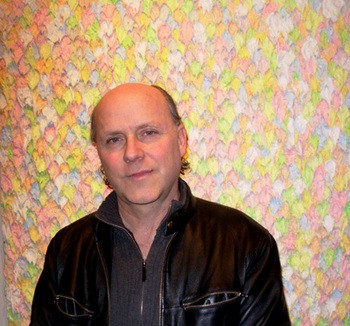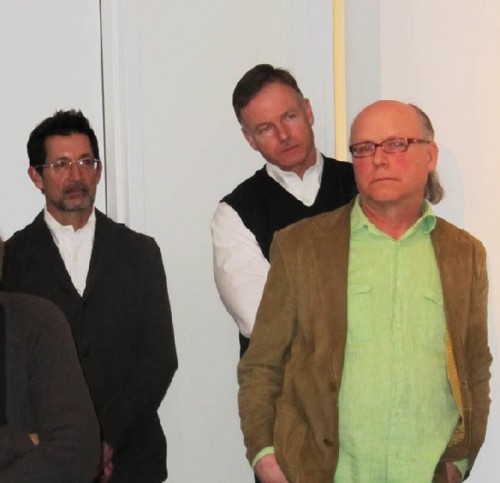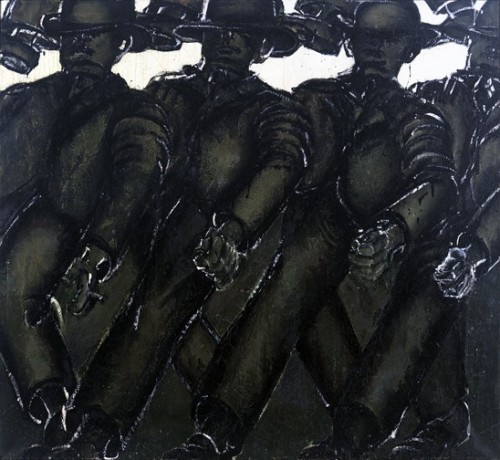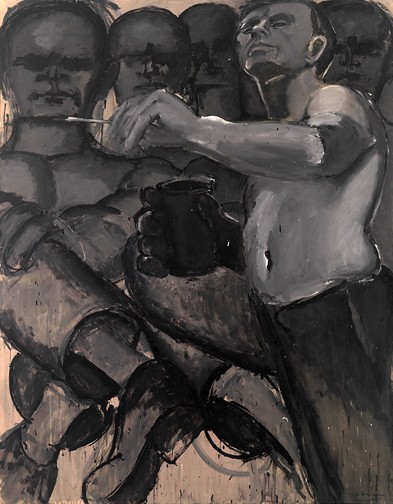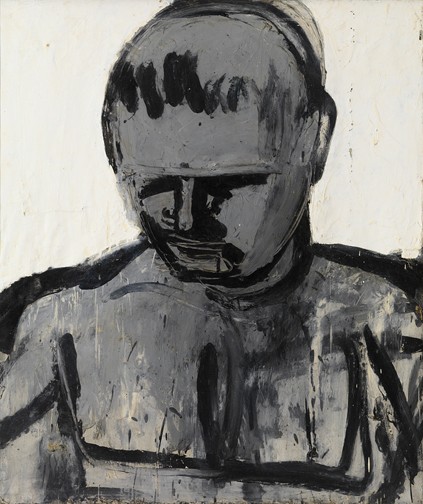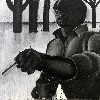Figurative Expressionist Lester Johnson
Retrieving the Existential Moment
By: Martin Mugar - May 03, 2011
History has established itself as the final arbiter of the value of the life the artist lives and the art they produce. Having navigated the art scene for over forty years , I have observed that the current manifestation of History’s evolution and the fear of not being part of it has been the cudgel that has been wielded by the arbiters of taste over the head of any poor fool who dares enter the arena of art.
I have images in my mind from “The Lord of the Rings” of Sauron, art critic, throwing Gandalf , artist into the abyss. This is not a world where sin will send you to eternal damnation; this is where the flavor of the month and whether you know what it is, can make you relevant or irrelevant. To get a sense of how one’s sense of self -worth is predicated on being aligned with “what’s happening”, just sit in on a graduate school critique or witness as I did your favorite class in color and observation get dropped from the curriculum by an administrative hack who wants to offer classes on gender theory.
The historical system that these arbiters use is that of the German philosopher Hegel. It is not a linear system of dates and events; it is a logic which states that History marches forward dialectically, each era supplanted by the next. This transition is dynamic, i.e. the current structure is challenged by a new one and eventually supplants it but not before there is a synthesis of the two. It is premised on the role of conflict. Therefore, it sees man as inextricably forced to interact with or against societal norms. He gains his consciousness there and has no identity outside of it. Hegel formulated his system during the French Revolution which for him was consciousness realizing itself on an historical plane.
The individual players were just acting out a huge cosmic plan. Individuality matters little except as it participates in or is transformed by the dialectic. History according to Hegel is a meat grinder, which shapes ordinary men into uniform hamburger patties that can be easily consumed by societal appetites.
His most devastating insight into History’s trope gives me chills when I read it: ” What is rational is real, what is real is rational”. How does it feel to be caught in this vise: Nothing can be real for us unless it is reduced to thought so that rationality becomes the only reality. It pretty much paints the picture of the 20thc.
Increasing rationalization of society by science interspersed with periodic paroxysm of horror at what has happened or delirious self- assertions of the self. The German Expressionist and the Abstract Expressionist shows side by side at MOMA represented those latter periods of individual revolt.
Every revolution and its participants of the past two centuries have all justified their acts, violent or otherwise, by an appeal to a more rational order. The goal of Hegel’s world is pure consciousness where there is no distinction between self and world as self and object as both are subsumed in pure reason.
In art, the evolution from representation to abstraction that was described by Clement Greenberg, a Hegelian, has the inevitability of the movement politically from monarchies to the modern state. Without this system of thinking there would be no mass culture, no zeitgeist or the repetition of generational selves that we are forced to identify with. It enframes how we dress, how we talk and how we paint.
The first inkling I got of the impact of this historical process in art oddly enough appeared to me in a late work of John Singer Sargent, exhibited at the MFA Boston some 16 years ago. It is a large mural of soldiers returning from WW 1 blinded by mustard gas, walking in a long line, the hand of the one behind on the soldier in front, the blind leading the blind. All are in uniform, somewhat tattered from battle, repeatable units without sight.
This is an uncanny image from the master of the exquisite moment, the painter of beautiful and egotistical upper class people of the Belle Époque surrounded by luxury and symbols of power; it is about blindness and uniformity. An artist, who had the ability and technique to represent anything placed in front of him, now shows an extraordinary courage in representing a new reality where the moment is deprived of nuance and subtlety, and the individual is reduced to a repetition of units where excessive observation is irrelevant. This is emblematic of the end of realism in a sense because the excessive sensory impact of bombs, shrapnel and mustard gas overwhelms any attempt by the senses to capture the world in a figurative fashion.
Abstraction will be the lingua franca of 20th c art where all the rough edges of the real will be filed off ultimately dissolving the human presence all together. Greenberg inspired as he was by Hegel established a theory of the visual that made that movement from representation to abstraction inevitable. Much of the evolution had already taken place by the time he defined it, but it accelerated the process by creating a theory that gave artists who wanted to jump on the art train a goal of total reduction that could be easily predicted and imitated. It is Hegel’s art of pure rationality and it slowly dissolves the world of the bourgeoisie replacing it with uniform, blind monads that can be shaped into abstract patterns for war or commerce.
In America of the ‘20s thru the ‘40s the realism of the Ashcan school and the Regionalists exist side by side with Abstraction but by the ‘50s Abstraction and Abstract Expressionism will have started a thirty year reign ending in the minimalism of the ‘70s and ‘80s. However, an ironic sort of realism appears in the form of Pop Art in the ‘60s and runs parallel to Abstraction.
According to the literature about Lester Johnson, its ascension to power helped marginalize the figurative expressionism that he was identified with. The critical community had allowed him to ride on the coattails of Abstract Expressionism as a sort of variant that kept the action of the gesture but brought the figure back into the painting.
Shifting the spot light away from Johnson to Pop art which, with its imitation of mechanical reproduction, put another nail in the coffin of any kind of representational art based on the individual either painting their real or psychological environment. It seemed there was no room for the deeply nuanced meditations of Lester on the relation of self and society.
Pop art is in fact the perfect product of the rationalized society that Hegel said we were moving toward; millions of mass-produced items that could not exist without the industrial technology to produce them and a mass culture manipulated by the media to purchase them. It was the new representation of man and society. The artists who painted in that style were considered by the art historians to be incredibly clever and even cunning tricksters in figuring out that the individual with all his ambiguous relation to others and society was dead. The Self was now a strange meta-self that existed only in the media. Warhol in his shamanic way understood how the media would lift up the individual to realize this meta-self for his fifteen minutes of fame only to let him subsequently descend into obscurity.
The media is our current equivalent of the pyramids, a collective project upon which millions slave to create and maintain. It is not for nothing that Warhol called his studio The Factory. The critics and artists who embraced this world view got to lord it over those artists with the epithet of Bourgeois, suffering from a false consciousness. I recently saw a biopic of Camus where Sartre leveled that insult at Camus . That insult and the following were the mantras I heard repeated throughout my career: Death to painting, Death to the individual. The air got sucked out of Lester’s expressionist world very quickly.
Maybe the distance we now have from the art world of the ‘60s, will allow us to reappraise the importance of Johnson’s work . A student today would have to look hard to locate it in the literature which shines its light on those movements surrounding it but bypasses his figurative endeavor. Maybe the inevitability of art history can be reversed or redirected. The current show at the Acme Gallery in Boston provides a broad swathe of his work that has helped this artist, who studied with him at Yale, rethink his importance.
His painting’s interface with the Abstract Expressionism out of which it grew and with Pop art, which supplanted it in the critical community, is complicated. First of all, he would be considered a second-generation abstract expressionist and secondly a figurative expressionist, so twice removed from the source.
Both de Kooning and Pollock ended their careers painting centrifugal works that are Whitman-like in their expansive notion of the self. They resemble the sensibility of Romantic American landscape painters such as Bierstadt or Frederick Church and become quintessentially American. Lester is no romantic. He sees the human condition as fraught with ambiguity grounded in the active human presence and by extension the human community. It is not mankind or humanity in the abstract that he paints, but “Da-sein”, the Heideggerian term which puts man beyond his self-consciousness into the human community without giving primacy to either one or the other.
Johnson’s early heads from the early to mid sixties ‘60s are emphatic in their message that we are here in this world not somewhere else. The implied effort of his stroke states that Lester Johnson is in a shared space with the head of the person he is representing. There is always a sense of decision in the splash of the paint on canvas. Man cannot avoid deciding for or against something. His frequent use of the Classical Greek head seems to say that this idea of man has always been with us. It is trans-historical, anti-Hegelian. His work has that knotty difficult quality of a Beckett play, where despite all the gestures and acts nothing is resolved; Human existence is reduced to its essence in “Waiting for Godot”, where act upon act doesn’t seem to resolve their angst. In the end they are there, just there.
Lester Johnson came of age in a generation that did not buy into ecstatic notions of pop culture. He did not lose himself in the social mood, like my generation does. He was not part of the generation that wanted to be “groovy” or “go with the flow” a generation that imprinted on mass media. They are the artists of the death of the individual, the exaltation of the corporate man. In that sense Pop also becomes the next quintessentially American art form. It is just a tip of the hat to those images crafted as artifacts created for mass culture.
The complexity of the self is gone as artists like Warhol glory in the vacuum that has been created. Johnson’s work is a much more nuanced and sophisticated revelation of the individual vs. the group. With his series of paintings of people joined arm in arm from the late sixties he acknowledges that people join groups; they lock hands like the Rockettes of Radio City Music Hall to act together as a crowd. Some recent writing on Heidegger makes the case that he did not use the term ”They” in a pejorative way. It was an inevitable aspect of da-sein, part of the human condition.
Lester Johnson could be considered asking the same questions as a phenomenologist trying to describe the shape of what it means to be human. However, being part of the group is not an unquestioned given as it was for the pop artist. The line up of generic men in Johnson’s work is often scary. They are reminiscent of the living dead that pour out of the Underground in T.S Eliot’s London. They are unsmiling and unaware of the condition that defines their identity with the group, carried along by some mass hysteria.
In his work of the Seventies and Eighties, the generation where the media co-opts every attempt of the individual to break the mold, the “They” in his work has changed its story. The light is brighter and sunnier. His characters are dressed each in different patterns of the period and although they are locked arm in arm like the bowler wearing men of the ‘50s they gaze out dreamily in different directions. Despite those slight gestures toward individuality they are still side by side. They are always plural not singular.
Lester Johnson places himself in the midst of the world Janus-like looking at the self and the group at once and asking so many questions: Who am I who is forced to decide and act? And who are “they” who act as a whole? Is there such a thing as “We”? And what is this hand that creates this image in a kind of existential act? Where do I end and the other start?
In one painting from the late sixties, he paints himself with a focus on his hand holding a brush in front of a painting of his men in the street asks the question” Who is this person, what is this hand who has created these characters.” Other self-portraits show a blunted hand as though the brush is tied to it reminiscent of the photograph of Renoir who had to tie a brush to his arthritic hand toward the end of his life in order to paint. The hand translates the world within to the canvas. Is he saying it is just an extension of the will and an instrument that is forced to blindly act, or is it too limited and clumsy to convey everything within? If you are capable of any subtlety in your thinking, these paintings will initiate it. They warrant multiple viewings and their graphic simplicity belies their complexity.
One drawing in the show at Acme that I took great pleasure in looking at was an ink brush drawing of a view through a window of the ocean in Provincetown from the fifties. The space depicted starting from a table and chairs in front of him, to the window frame, then the porch and finally the boats on the water are all rendered by the same black unmodulated stroke. The space is compressed and all the things are simply depicted. My first thought on looking at it, was that this guy is visually astute. He can draw.
I remember that he was the only faculty member at Yale to talk with me one on one about my thesis show. He said he admired the kind of space I had created in my still life’s, which were in fact very flattened out and very influenced by Matisse .He had understood the importance of space even within flatness and how without space Matisse would only have been a mere designer. I thought as well of how drawing is not offered in grad school at Yale anymore, at least according to a conversation Bernie Chaet had with the current Dean Robert Storr while Chaet was doing his portrait (interestingly enough a portrait with blue smudges instead of eyes). How do you abstract from the real in front of you; is it only an old fashioned exercise in epistemology? Is there any nature left to learn from as we spend most of our lives in front of the computer screen. Lester created so much light in that drawing by activating the page with his use of black. Such old fashioned concepts: space and light.
How do we work our way back to Johnson’s work and let it tell its story? Current art criticism and the art of the academy because it is under the thrall of Duchamp with the primacy of ideas over the optical, is highly critical of painting that carries a scent of representation, as though someone like Johnson’s work does not think; The art criticism of the past leaves him towered over by their mythological treatment of the Abstract Expressionists and Pop Art.
I hope that what little I have written here lets us see that Lester Johnson’s work is a profound meditation on our being in the world, with all the ambiguities between self and society. A psychologist and a sociologist can use these terms to describe the structure of both but they can’t tell you how it feels to be a self among others and witness to the masses of people in the modern city who define themselves as a single self. What do all those definitions look like? The hand knows more than the conscious mind. Lester trusted it to reveal secrets about our world and self that the mind could only over-simplify.
He knew that to paint/see with a brush at the end of your hand as an extension of the body and the mind allowed him to discover unconscious insights not explicit in our day-to-day existence. This discovery was an event in paint . To the contemporary artist who accepts that they are doomed or destined (sometimes I don’t know which verb applies) to express themselves in a language of painting that in kindergarten was the universal language by which every child described their world and became an expressive medium in the 20thc in the hands of Picasso, Miro, Kandinsky and their American students, Gorky, deKooning and Pollock, they should find much to give them comfort and inspiration in viewing and studying Lester’s work.
Painting treads a path of cognition unique to the visual artist .It must break free of the burden of history and the predications of the priestly class of intellectuals who establish a priori what can or cannot be done in the world of art. That class has been enormously successful; there is currently one show in the galleries world-wide, whether in Paris, Rome New York or Shanghai: Photo originated image on the wall, a found object on the floor and a title about the oppression of some group excluded from the Hegelian dialectic. An artist must say like Lester: ”Here I stand.This is my experience and this is how it feels to be alive. ”
HANDROSE
You almost became
“They”
Your rockettes
Arm in Arm.
Or Eliot’s living dead
That flowed over London Bridge.
The Brooklyn
That Miller left for
Paris and from a private paradise
Shaped the flower of the
70’s (1)
You stuck it out.
You knew that it all added up to
Nothing, anyway.
Sacrificed the
caress of private moments to
monitor the storm troopers
Marching to and from work.
One day in front of your stolid men
last weeks stump
Bloomed. Your tortured hand
(1)Miller’s grim images of Brooklyn in “The Tropic of Cancer” make me think of Johnson’s men. Miller escaped New York and created a private love nest with Anais Nin in Paris, out of which grew private notions of self-realization that were fodder for the delirious sex drugs and rock and roll culture in the California of the sixties and seventies. Mamet in a recent essay on American theatre sees Eliot and Pound as escapists and I am sure he would throw Miller into this category. Lester’s world is one of men who are compelled to act not knowing what the consequences are. Somewhat like a Mamet play, Johnson’s painting has a stolid determination about it.

